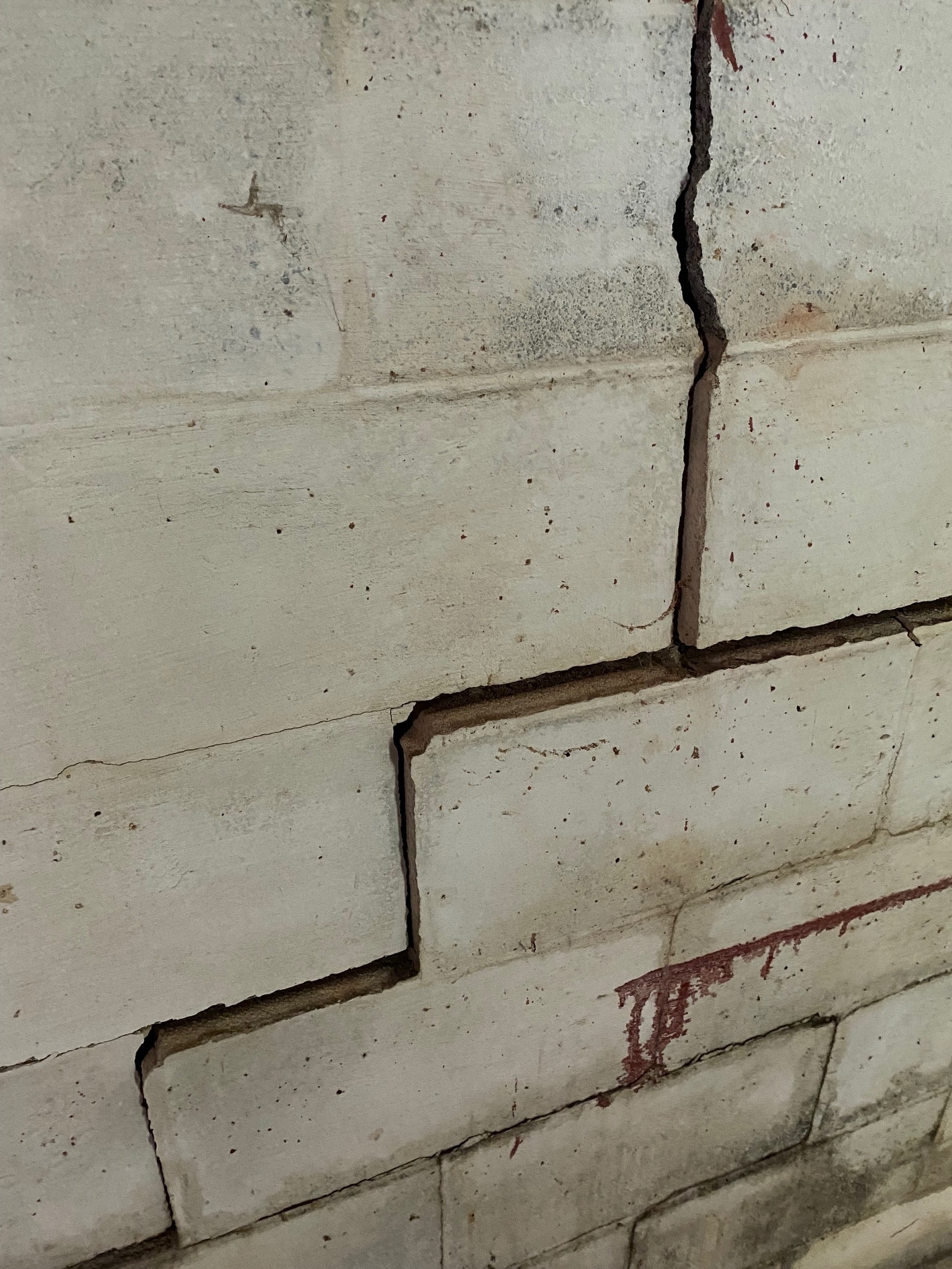
Most homeowners assume that foundation problems only affect the lowest parts of the house, the basement, crawl space, or slab. But what happens at the base doesn’t stay at the base. In reality, when your foundation begins to shift or deteriorate, the effects can ripple upward through the entire structure, ultimately compromising the second story of your home.
Cracks in upstairs walls, uneven floors on the second floor, or doors that suddenly don’t close right may all be signs of trouble below. In this article, we’ll explore how foundation issues impact upper levels of a home, the types of damage they cause upstairs, and what Seal-Tite Basement Waterproofing can do to address the root cause.
🔑 Key Takeaways
- Foundation movement affects not only basements and crawlspaces but also upper floors.
- Signs like wall cracks, ceiling gaps, and crooked doors on the second story often originate in the foundation.
- Uneven settlement causes distortion throughout the entire structure.
- Proper foundation repair realigns and reinforces the home from the ground up.
- Early action prevents more extensive — and more expensive — upper-level damage.
How Foundation Problems Travel Upward
The structure of your home behaves like a connected system. The foundation supports the load-bearing walls, which in turn support the upper floors and roof. When the base shifts, everything built on top responds to the stress.
Here’s how foundation issues lead to second-story problems:
1. Differential Settlement
When part of your foundation settles more than another (commonly due to soil instability), it creates an uneven support plane. Walls above begin to shift, twist, or bow, causing cracking and misalignment upstairs.
2. Foundation Rotation
If a foundation wall or footing tilts, even slightly, it can throw off the entire alignment of the home — like tilting a bookshelf and watching everything on it shift.
3. Framing Stress
As structural components are pulled out of square, they place extra stress on joists, studs, and ceiling beams on the second floor, which may lead to:
- Nail pops
- Wall cracking
- Floor sagging
4. Moisture Intrusion and Material Decay
Moisture entering through a compromised foundation can travel upward through framing or drywall, eventually affecting flooring and wall finishes upstairs.
Signs of Foundation Trouble on the Second Floor
Most people expect to see foundation warning signs in the basement — but the second story may speak louder if you know what to look for:
| Symptom (Upstairs) | What It Might Indicate |
|---|---|
| Cracks in drywall above door frames | Structural frame shifting from below |
| Doors sticking or not closing properly | Foundation unevenness causing misalignment |
| Floors creaking or sloping | Settlement or joist strain due to foundation movement |
| Cracks where walls meet ceilings | Flexing or pulling caused by vertical displacement |
| Gaps in molding or baseboards | Shifting walls or floors due to structural distortion |
| Windows hard to open or stuck | Twisting window frames from foundation-related torque |
Real-Life Example: Second Floor, First Warning
A family in Salem, VA, noticed a long crack forming across their master bedroom ceiling — right above a doorway. Over a few months, the door began sticking, and the bathroom floor had a noticeable slope.
They assumed it was an upstairs framing problem, but a foundation inspection from Seal-Tite revealed:
- A corner of the home’s foundation had settled more than 2 inches.
- The shifting had subtly pulled structural elements out of alignment over time.
- Soil erosion near the rear patio was contributing to continued movement.
Solution Provided:
- Installed helical piers under the settling corner to lift and stabilize the foundation.
- Re-leveled floor framing and repaired cracks in the walls and ceiling.
- Corrected the grading near the rear of the home to divert water away from the foundation.
By fixing the problem at the source, the second-floor symptoms were permanently resolved.
How Foundation Repair Resolves Second-Story Damage
Fixing upstairs problems without addressing the foundation is like painting over rust — it may look better for a while, but the problem continues underneath.
Here’s how foundation pros address the full picture:
1. Structural Evaluation
- Full home inspection, including second story and attic framing
- Laser leveling and floor elevation measurements
- Soil and drainage assessment around the foundation
2. Foundation Stabilization
Depending on the cause and extent of movement:
- Helical or push piers are installed to lift and stabilize the foundation.
- Underpinning is used to reinforce existing footings.
- Carbon fiber straps or steel I-beams are applied to support bowing walls (if present).
3. Moisture Management
Water is often the driver of soil instability and foundation movement:
- French drains
- Sump pumps
- Grading improvements
- Gutter and downspout extensions
All are part of the long-term solution.
4. Interior Realignment and Repairs
After the foundation is stabilized, repairs to interior finishes — such as re-hanging doors, patching drywall, and leveling floors, can be done with confidence that they won’t just crack again.
Why It’s Important to Act Early
Second-story symptoms might seem disconnected from foundation problems — but waiting too long can lead to:
- Costly finish repairs (ceilings, floors, drywall)
- Damage to structural framing and roof systems
- Electrical or plumbing stress due to misalignment
- Lower property value or difficulty during resale inspections
The longer you wait, the more damage creeps upward.
FAQs: Second Story and Foundation Damage
Can cracks in upstairs walls really come from the basement?
Yes. In many cases, cracks or distortions upstairs are directly caused by shifting below — especially in load-bearing areas.
My second floor feels sloped — is that a framing issue?
It might be. But if the framing is intact and the slope has worsened over time, the problem likely originates in the foundation.
Will fixing the foundation also fix cracks upstairs?
Stabilizing the foundation will stop further movement. Some cracks may close slightly after lifting, but cosmetic repairs are typically needed for a clean finish.
How much does it cost to fix this kind of issue?
It depends on the severity and type of foundation movement. Pier systems, for example, may range from $3,000–$15,000+ depending on how many are needed.
Can I sell a house with second-story cracks?
Buyers may be hesitant if the cause is unclear. A professional foundation inspection (with documentation) helps maintain buyer confidence.
Conclusion: If the Upstairs Is Shifting, Look Down
When problems appear on the second floor, it’s natural to assume they’re isolated — but often, they’re signs of something much deeper. Foundation settlement, movement, or instability doesn’t stop at ground level. It sends shockwaves upward, affecting every room, floor, and finish above it.
If you’ve noticed cracks, sloping, or other changes upstairs, it’s time to look down — and act fast. The foundation may be trying to tell you something.
Contact Seal-Tite Basement Waterproofing for a complete foundation inspection. We’ll assess your entire structure, from the basement to the roof — and design a long-lasting solution that keeps your home level, secure, and strong at every level.

Seal-tite Basement Waterproofing Co. is a full service basement environment contractor. We carry an A+ Better Business Bureau rating. We repaired over 40,000 homes and structures in Virginia, West Virginia, Tennessee, and North Carolina. We are fully insured and licensed. We have worked in all types of locations, including residential and commercial locations, government agencies, colleges, hospitals, churches, and condo associations.
Seal-tite® offers a lifetime transferable warranty. We carry a Class A Contractor’s License and we are fully insured. Our satisfied customers range from government agencies to businesses, hospitals, colleges, churches, and thousands of homeowners. Your home is probably the single largest investment you will make in your lifetime. Don’t wait, call Seal-tite® to help make your home dry, safe and livable.

